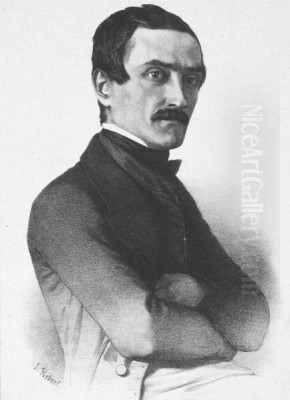
Alexandre Calame stands as one of the most significant figures in 19th-century Swiss art, celebrated primarily for his evocative and dramatic landscapes of the Alps. Born during a period of burgeoning Romantic fascination with untamed nature, Calame captured the grandeur, power, and intricate beauty of his native mountains with a unique blend of meticulous realism and profound emotional depth. His work not only defined a particular vision of the Swiss landscape but also resonated across Europe, earning him international acclaim and influencing a generation of artists. He became synonymous with the Alpine sublime, translating onto canvas the awe-inspiring vistas that were increasingly drawing travellers and artists to Switzerland.
An Unlikely Beginning: Early Life and Calling
Alexandre Calame was born on May 28, 1810, in Arabie, then a distinct area but now part of Vevey, Switzerland, situated on the picturesque shores of Lake Geneva. His origins were modest; his father was a skilled marble worker. Calame's childhood was marked by a significant hardship: a severe accident resulted in the loss of sight in one eye. This physical challenge, which might have deterred others from pursuing a visual art form, seems only to have sharpened his focus and determination in his later artistic endeavours. It speaks volumes about his resilience and innate passion for visual expression that he overcame this obstacle to become a painter celebrated for his keen observation.
Financial necessity dictated his early path. Following his father's early death or departure, the family faced difficulties. At the young age of 15, Calame began working in a bank in Geneva. His primary motivation was practical: to support his mother and secure a stable income. However, the world of finance could not contain his burgeoning artistic inclinations. During his time at the bank, he began experimenting with drawing and painting in his spare time, creating small landscapes that hinted at his latent talent. These early works, often depicting scenes around Geneva, began to attract notice.
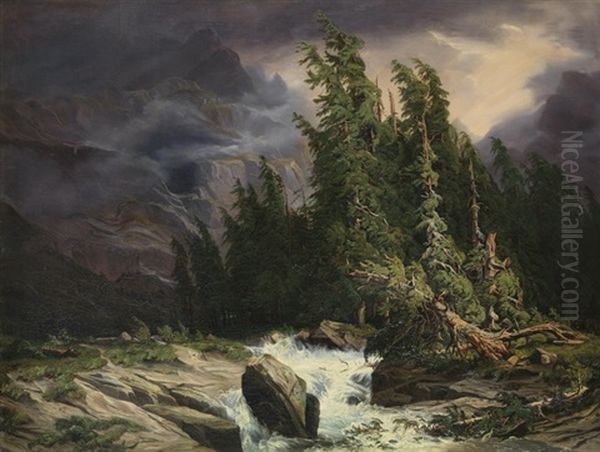
A pivotal moment arrived in 1829 when his artistic promise caught the attention of a wealthy Genevan banker and patron of the arts, Jacques Revilliod de Muralt (often cited by the family name Diodati, related through marriage). Recognizing Calame's potential, Diodati generously offered to fund his formal art education. This patronage was the turning point, allowing Calame to leave the security of the bank and dedicate himself entirely to his true passion: painting. It was an act of faith that launched the career of one of Switzerland's most renowned artists.
Under the Master's Eye: Training with Diday
Freed from his banking duties thanks to Diodati's support, Alexandre Calame sought formal instruction. In 1829, he entered the studio of François Diday (1802-1877), who was already an established and respected landscape painter in Geneva. Diday himself specialized in Alpine scenes, known for his somewhat dramatic and robust depictions of mountains and lakes. He provided Calame with a solid foundation in the techniques of oil painting and landscape composition, emphasizing direct observation of nature, albeit often finalized with a degree of studio idealization common at the time.
Calame proved to be an exceptionally quick learner. He absorbed Diday's teachings but soon began to develop his own distinct style, often characterized by a greater sensitivity to atmospheric effects and a more refined handling of light and detail than his teacher's work. Despite developing his own path, the relationship with Diday was crucial. It provided Calame not only with technical skills but also with an entry into the Geneva art scene and an understanding of the market for landscape painting, particularly the growing demand for Alpine views from tourists and collectors.
By 1830, Calame felt confident enough to begin establishing his own presence. He started creating small etchings and lithographs depicting Swiss views. These prints were relatively affordable and proved popular, particularly among the increasing number of tourists visiting Switzerland, eager for souvenirs of the spectacular scenery. This early venture provided him with a measure of financial independence and helped spread his name. Around the same time, or shortly thereafter, he opened his own studio or gallery space, signalling his arrival as a professional artist ready to make his mark. His rapid progress from novice student to independent artist in just a few years was remarkable.
The Majesty of the Alps: Subject and Inspiration
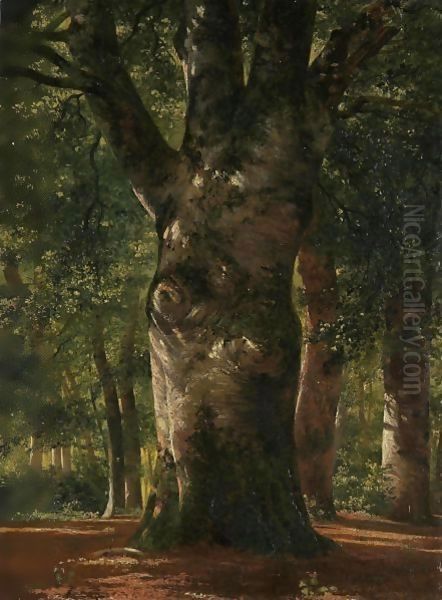
While Calame painted various landscapes, including forests and scenes from his travels abroad, the Swiss Alps remained his most profound and enduring source of inspiration. He was captivated by their immense scale, dramatic forms, and ever-changing moods. His work became intrinsically linked with the Alpine landscape, particularly the majestic peaks, deep valleys, rushing torrents, and ancient glaciers of regions like the Bernese Oberland (areas around Grindelwald, Lauterbrunnen, Meiringen, Handeck) and Central Switzerland.
Calame undertook numerous sketching expeditions into the mountains, often during the summer months. He would spend weeks hiking and drawing directly from nature, filling sketchbooks with detailed studies of rock formations, specific trees, cloud patterns, waterfalls, and light effects at different times of day. This practice of en plein air (outdoor) sketching provided the raw material and authentic detail for his larger, more elaborate studio paintings. He believed deeply in grounding his art in careful observation, even as he imbued his finished works with Romantic sentiment.
The Alps, during the 19th century, were increasingly seen not just as formidable natural barriers but as sources of the sublime – experiences that evoked awe, wonder, and even a sense of delightful terror in the face of nature's overwhelming power. Calame's paintings tapped directly into this Romantic sensibility. He excelled at conveying the loneliness of high mountain passes, the dramatic intensity of approaching storms, the serene beauty of sunlit peaks emerging from mist, and the raw power of waterfalls like those at Handeck. His work resonated with a public fascinated by the wild, untamed aspects of nature, offering a visual counterpart to the writings of Romantic poets and philosophers.
Defining a Vision: Calame's Artistic Style
Alexandre Calame's artistic style is often described as a masterful synthesis of Northern Romanticism and meticulous Realism. He possessed a remarkable ability to render the specific details of the natural world – the texture of granite, the intricate branching of a pine tree, the transparency of glacial ice – with almost scientific precision. This commitment to accuracy likely stemmed from his direct observation studies and perhaps resonated with the era's growing interest in geology and natural sciences. His depictions of trees, such as ancient, gnarled pines or sturdy beeches, were particularly admired for their individuality and character.
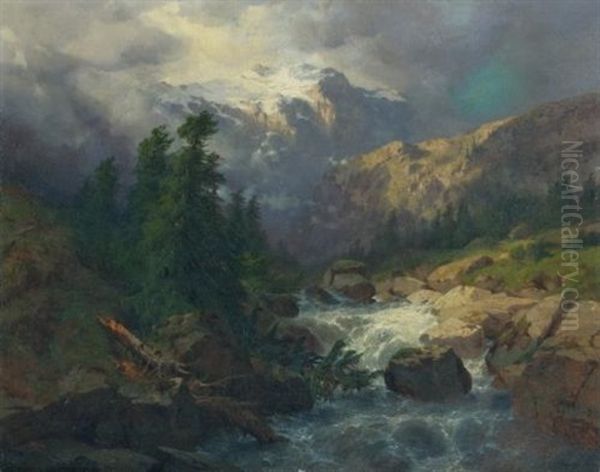
However, Calame was far more than just a topographical recorder. He infused his detailed renderings with a powerful sense of atmosphere and emotion characteristic of Romanticism. His use of light and shadow (chiaroscuro) was particularly masterful. He could manipulate light to create dramatic contrasts, highlight specific features, evoke a particular time of day, or instill a scene with a palpable mood, whether it be the somberness of an approaching storm, the tranquility of twilight, or the dazzling clarity of high-altitude sunlight. His skies are often active participants in the drama, filled with dynamic cloud formations or subtle gradations of colour.
His compositional choices often emphasized the vastness and verticality of the Alpine environment, sometimes using human figures or chalets dwarfed by the surrounding peaks to enhance the sense of scale and the sublime power of nature. While influenced by 17th-century Dutch landscape masters like Jacob van Ruisdael and Meindert Hobbema, particularly in their detailed rendering of foliage and skies, Calame's subject matter and dramatic intensity set him apart. He also absorbed lessons from contemporary French landscape painting, perhaps the structured naturalism of some Barbizon School painters like Théodore Rousseau or the atmospheric sensitivity of Jean-Baptiste-Camille Corot, yet his focus remained firmly on the unique character of the Alps, rendered with a Northern European sensibility. His style found parallels in the dramatic landscapes of the Düsseldorf School painters like Andreas Achenbach and Oswald Achenbach in Germany.
Masterpieces of the Mountains: Signature Works
Calame's reputation was cemented by several key works that showcased his unique talents. One of his earliest and most significant triumphs was Orage à Handeck (Storm at Handeck). Exhibited at the prestigious Paris Salon in 1839, this painting captured the dramatic moment of a thunderstorm breaking over the Handeck Falls in the Bernese Oberland. Its powerful depiction of natural forces and atmospheric turmoil deeply impressed the Parisian art world, earning Calame a gold medal. This award significantly boosted his international standing and brought numerous commissions.
Throughout his career, Calame returned to favourite locations and themes. The Handeck region, with its dramatic gorge and waterfall, remained a recurring subject, as seen in later works like At Handeck (circa 1860), which might offer a different mood or perspective compared to the famous storm scene. His studies of specific natural elements were also highly regarded. Tronc de hêtre (Beech Trunk), painted around 1850, is a prime example of his ability to elevate a seemingly simple subject – the trunk of a beech tree – into a compelling study of form, texture, and resilience, celebrating the intricate beauty found in nature's details.
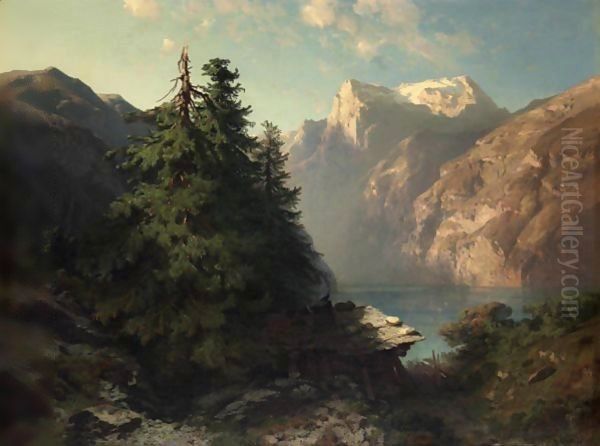
Other notable works further illustrate his range and mastery. Stormy Weather (1858) revisits the theme of dramatic Alpine weather, showcasing his skill in rendering turbulent skies and wind-swept landscapes. Boulders by a Lake (1857-61) highlights his interest in geological forms and the play of light across surfaces. Paintings like The Lake of Thun offered calmer, more idyllic perspectives on the Swiss landscape, demonstrating his versatility. Beyond oil paintings, Calame was a prolific printmaker, producing numerous lithographs and etchings that helped disseminate his Alpine visions to a wider audience and are considered an important part of his oeuvre. These prints often focused on specific motifs like characteristic trees, rocks, or mountain cabins.
Beyond Switzerland: Travels and Artistic Exchange
While forever associated with the Swiss Alps, Alexandre Calame understood the importance of broadening his artistic horizons through travel. He journeyed extensively throughout Europe, seeking inspiration, studying the works of Old Masters and contemporaries, and exploring different types of landscapes. These travels were crucial for his artistic development, allowing him to refine his techniques and absorb diverse influences. He visited Germany, the Low Countries (Belgium and the Netherlands), and England, exposing himself to different artistic traditions and landscape aesthetics.
His trip to Italy in 1844-1845 was particularly significant. Like many Northern European artists before him, he was drawn to the classical ruins and the unique light of the Italian peninsula. He spent time in Rome and Naples, sketching ancient monuments and coastal scenery. This journey resulted in several important paintings, including depictions of the famous Greek temples at Paestum, near Naples. These works showcase his ability to apply his precise rendering skills and sensitivity to light to subjects far removed from his familiar Alpine environment, demonstrating his versatility.
Calame's growing fame meant his travels were also intertwined with his professional success. His works were exhibited in major European capitals, including Paris, Berlin, and London, earning him medals and prestigious memberships in various art academies. His international reputation attracted high-profile admirers. Notably, Emperor Napoleon III of France purchased one of his paintings and reportedly invited Calame to visit Southern Italy, a testament to the artist's standing at the highest levels of European society. These journeys and the resulting international exposure solidified Calame's position as a leading figure in European landscape painting, not just a Swiss specialist.
A Legacy of Learning: Calame as Teacher and Influence
Alexandre Calame was not only a successful painter but also a highly influential teacher. His Geneva studio became a magnet for aspiring landscape artists from Switzerland and abroad. He transmitted the skills and artistic vision he had honed, emphasizing rigorous drawing, careful observation of nature, and the techniques required to capture the complexities of Alpine scenery and atmospheric effects. His teaching methods likely combined studio instruction with encouragement for students to undertake their own sketching trips in the mountains.
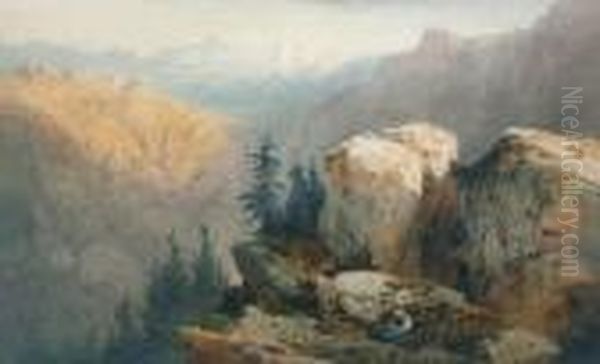
Several prominent artists benefited from Calame's guidance or were significantly influenced by his work. Perhaps the most famous is Ferdinand Hodler (1853-1918), a leading figure in Swiss Symbolism and Art Nouveau. Hodler's early landscapes clearly show the impact of Calame's detailed naturalism and focus on Alpine subjects, before Hodler developed his own distinctive, more stylized approach known as Parallelism. Another major Swiss artist associated with Calame is Arnold Böcklin (1827-1901), primarily known for his Symbolist mythological scenes. Böcklin reportedly studied landscape painting, possibly briefly with Calame or certainly under his strong influence, in Geneva during the late 1840s, absorbing the emphasis on dramatic natural settings.
Calame's influence extended beyond Switzerland. The Italian painter Bartolomeo Ardy was one of his students and went on to become a notable figure in Italian landscape painting. His studio attracted pupils from Germany, France, Russia, and even America, helping to spread his approach to landscape painting internationally. Through his teaching and the widespread admiration for his work, Calame played a crucial role in shaping the direction of landscape painting in the mid-19th century, particularly the genre of Alpine painting, ensuring that his vision of the mountains would inspire artists for decades to come.
Calame in Context: Contemporaries and Landscape Painting
To fully appreciate Alexandre Calame's achievement, it's helpful to place him within the broader context of 19th-century landscape painting. He emerged during a period when landscape was rising in status, moving from a minor genre to a major form of artistic expression, particularly within the Romantic movement. His direct teacher, François Diday, was a key figure in establishing Alpine painting in Geneva, creating a foundation upon which Calame built. Earlier Swiss artists like Caspar Wolf (1735-1783) had pioneered the depiction of the Alps, but Calame brought a new level of technical refinement and Romantic sensibility to the subject.
Internationally, Calame's work can be seen in dialogue with several major trends. In Britain, J.M.W. Turner (1775-1851) and John Constable (1776-1837) were revolutionizing landscape painting with their respective focuses on atmospheric light and the direct study of nature, albeit with very different stylistic outcomes than Calame's. In France, the Barbizon School, including painters like Théodore Rousseau (1812-1867), Charles-François Daubigny (1817-1878), and Jean-Baptiste-Camille Corot (1796-1875), emphasized intimate, naturalistic depictions of forests and rural scenes, often painted outdoors. While Calame shared their commitment to nature, his subjects were typically grander and more dramatic.
The Düsseldorf School in Germany, with artists like Andreas Achenbach (1815-1910) and Oswald Achenbach (1827-1905), produced dramatic, often narrative landscapes that shared some similarities in mood and technical polish with Calame's work. Across the Atlantic, the Hudson River School painters, such as Albert Bierstadt (1830-1902) and Frederic Edwin Church (1826-1900), were tackling the sublime landscapes of the Americas, echoing Calame's engagement with vast, awe-inspiring natural scenery. Calame's fame also reached Russia, where landscape painters like Ivan Shishkin (1832-1898), known for his detailed forest scenes, would have been aware of his work, especially given the connections between Russian and Swiss artistic circles at the time. Calame carved out a distinct niche within this international landscape, becoming the preeminent painter of the Alpine sublime.
Final Years and Enduring Reputation
Alexandre Calame remained active as an artist throughout the 1850s and into the early 1860s, continuing to produce impressive Alpine landscapes and studies from nature. His reputation remained high both in Switzerland and internationally. His works were sought after by collectors, and he continued to exhibit widely. However, his health began to decline, possibly exacerbated by the rigours of his frequent mountain expeditions and demanding studio work.
Seeking a milder climate, perhaps for health reasons, Calame travelled to the French Riviera. He died relatively young, at the age of 53, on March 17, 1864, in Menton, France. His death marked the end of a remarkable career that had significantly shaped the course of Swiss art and contributed richly to the European tradition of landscape painting.
Today, Alexandre Calame's legacy endures. He is recognized as a pivotal figure in Swiss art history, one of the first Swiss artists to achieve widespread international fame. His paintings are held in major museum collections across the world, including the Musée d'Art et d'Histoire in Geneva, the Kunsthaus Zürich, the Louvre in Paris, the Hermitage Museum in St. Petersburg, and numerous other institutions in Europe and America. His depictions of the Alps continue to captivate viewers with their blend of detailed realism and romantic grandeur, offering a powerful vision of mountain landscapes that defined an era's perception of the sublime in nature. He remains a key reference point for the study of 19th-century landscape painting and the artistic representation of the Alps.
Conclusion: The Alpine Visionary
Alexandre Calame's contribution to art history lies in his profound and compelling interpretation of the Alpine landscape. Emerging from humble beginnings and overcoming personal adversity, he rose to become one of the most celebrated landscape painters of his generation. His unique ability to fuse meticulous observation of natural detail with the dramatic sensibility of Romanticism allowed him to capture the sublime power and intricate beauty of the Swiss Alps as few others have. Through iconic works like Storm at Handeck and countless other paintings, etchings, and lithographs, he shaped an enduring vision of the mountains that resonated deeply with his contemporaries and continues to inspire awe today. As a master technician, an influential teacher, and an artist of international renown, Calame secured his place as a true visionary of the Alpine world, leaving behind a legacy as monumental as the peaks he so masterfully depicted.